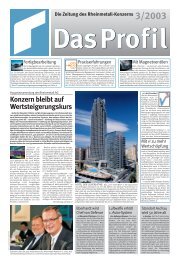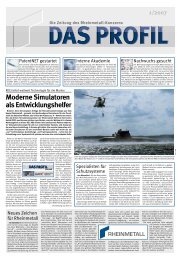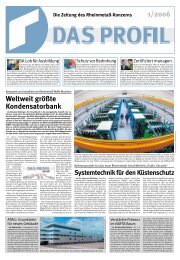PDF [1.6 MB] - Kolbenschmidt Pierburg AG
PDF [1.6 MB] - Kolbenschmidt Pierburg AG
PDF [1.6 MB] - Kolbenschmidt Pierburg AG
You also want an ePaper? Increase the reach of your titles
YUMPU automatically turns print PDFs into web optimized ePapers that Google loves.
egulating the exhaust gas inflow, depending<br />
on temperature, the flap ensures<br />
that the converter is more or less<br />
always working to optimum efficiency,<br />
a factor that also extends its servicelife<br />
considerably.”<br />
“Another example,” continues the 58year-old<br />
exhaust gas specialist “is to<br />
ensure compliance with future EURO 5<br />
standards which specifically in the case<br />
of diesel engines increasingly call for<br />
low-pressure EGR for achieving an especially<br />
high rate of recirculation. There<br />
is also the sequential turbocharger feature,<br />
of growing significance on diesel<br />
engines, where an additional smaller<br />
turbocharger ensures that the power<br />
boost available is delivered even at low<br />
engine speeds.<br />
Last but not least,<br />
noise control on<br />
upscale vehicles<br />
is a factor for consideration;various<br />
sound profiles<br />
are selectable,<br />
from a muffled<br />
to a throaty<br />
sports car style<br />
roar.” “Neither<br />
should we forget,”<br />
adds Lösing,<br />
“the EGR<br />
valves for commercial<br />
vehicles<br />
that work at temperatures<br />
of up to<br />
180° C under punishing<br />
conditions<br />
of aggressive exhaust<br />
condensate<br />
and pressure<br />
surges as steep<br />
as 1,300 bar/sec. These valves are necessary<br />
to ensure that trucks and buses,<br />
too, can comply with current and future<br />
emission standards.”<br />
Javier Egurrola continues: “What really<br />
distinguishes us from competition is<br />
the know-how and experience of our<br />
employees accumulated through more<br />
than 30 years of market presence, and<br />
enabling us nowadays to mix and<br />
merge a diversity of components (e.g.<br />
EGR valve with bypass or the new cooler),<br />
thus creating new, innovative and<br />
nonetheless rugged products matching<br />
the highest standards of quality and<br />
customer demands. Our entire team as<br />
well as their profound knowledge re-<br />
Newsline<br />
<strong>Pierburg</strong> GmbH’s Emission Control business unit powerfully positioned worldwide<br />
A specialist in emission reduction<br />
(Continued from page 12)<br />
garding our products and present and<br />
future emission control techniques<br />
and, not least of all, the expectations<br />
and needs of our customers—these are<br />
the key factors that set us apart from<br />
competition.”<br />
As to the future, the Emission Control<br />
business unit perceives itself as strategically<br />
well positioned. Egurrola: “The<br />
advantage of having an autonomous<br />
profit-center style business unit is that,<br />
unlike previously, it assumes full responsibility<br />
for such factors as design,<br />
timing, profit and quality throughout a<br />
product’s lifecycle. Secondly, the business<br />
unit is focused on a specific product<br />
sector and can leave the development<br />
of tomorrow’s products to the Advanced<br />
Engineering department. This,<br />
Powerfully positioned product portfolio: Dr. Karl-Heinrich Lösing (l.) Senior Manager<br />
Development EGR (trucks) and Exhaust-Gas Flaps and his Secondary Air Systems<br />
coworker, Dr. Holger Paffrath, with the latest high-temperature exhaust gas flap.<br />
in turn, results in a more efficient division<br />
of labor. And, finally, a structure<br />
such as this functions according to a<br />
global vision that starts with group<br />
guidelines and is reflected in the global<br />
coordination and meshing of activities<br />
within the various departments<br />
and branches with a view to achieving<br />
a common goal. All this gives us the energy<br />
to confidently cope with future developments<br />
and actively help shape<br />
the future of the automobile.”<br />
<strong>Pierburg</strong> expert Lösing has a quite<br />
specific notion of how this future will<br />
shape out. “We can be certain that in<br />
future the entire area of engineering<br />
development and simulation will play a<br />
13<br />
much more predominant role in the relationship<br />
between the carmakers and<br />
their suppliers. Also likely to undergo<br />
considerable change are the requirements<br />
regarding flexibility in terms of<br />
engineering design changes and the<br />
perception of the engine and the auto<br />
as complete systems in themselves.”<br />
Adds Sari, his engineering colleague:<br />
“In future, our customers will require<br />
even more than today technical support<br />
in the design and test phases.<br />
They will also expect us to park on their<br />
premises one of our application engineers<br />
for direct consultation.”<br />
A glance at the list of projects currently<br />
in the pipeline indicates that the<br />
Emission Control business unit is focusing<br />
its product range closely on futurerequirements<br />
and emission<br />
standards.<br />
Alongside a new<br />
generation of EGR<br />
valves, we find<br />
such undertakings<br />
as EGR<br />
valves for commercial<br />
vehicles<br />
or for exceptionally<br />
high flow<br />
rates, others with<br />
an integrated bypass<br />
function or<br />
else for low-pressure<br />
operation. A<br />
further item on<br />
the agenda is an<br />
optimized sec-<br />
Photo: Markus J. Ferger<br />
ondary air sys-<br />
tem.<br />
Javier Egurrola<br />
concludes: “The<br />
new business<br />
unit set-up is a sustainable system to<br />
help us achieve present and future performance<br />
targets. Since its conception<br />
we have attained over 30 percent<br />
added productivity through the resulting<br />
changeover in process layout and<br />
materials flow. Moreover, through improved<br />
First Time Quality (FTQ) we have<br />
managed to upgrade our Overall Equipment<br />
Efficiency (OEE), in some cases<br />
by over 50 percent. Measured against<br />
our business plan we have also shown<br />
a 17-percent sales boost. From such a<br />
promising baseline we are certain of<br />
having laid for ourselves a sound foundation<br />
and hence look forward to solid<br />
business progress in the years ahead.”


![PDF [1.6 MB] - Kolbenschmidt Pierburg AG](https://img.yumpu.com/8657804/13/500x640/pdf-16-mb-kolbenschmidt-pierburg-ag.jpg)
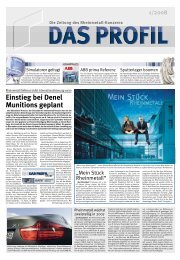



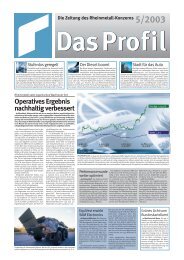
![PDF [2.4 MB] - Kolbenschmidt Pierburg AG](https://img.yumpu.com/8295864/1/184x260/pdf-24-mb-kolbenschmidt-pierburg-ag.jpg?quality=85)
![PDF [2.5 MB] - Kolbenschmidt Pierburg AG](https://img.yumpu.com/8112793/1/184x260/pdf-25-mb-kolbenschmidt-pierburg-ag.jpg?quality=85)




